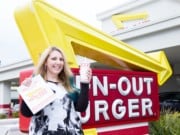So hobbies work a little something like this: you find something you enjoy doing. You do it all the time, even though you don’t get paid. In fact, you pay for the privilege of doing this fun thing because you probably can’t do it without lessons or special equipment. Get better. Have even more fun.
People who dabble in photography buy lenses for their camera. Birdwatchers invest in binoculars, golfers purchase new clubs, Trekkers get Tricorder apps for their iPhone (don’t judge). Geeking out with gear opens up dimensions of our hobby we could otherwise never reach.
Bakers relish in these upgrades more than most. Ice cream makers, bread machines, stand mixers, food processors, adorable bundt pans, waffle irons, rolling pins, cake-pop makers (seriously?), brownie corner pans, lollipop molds, copper pots and a hundred other highly specialized and often expensive tools.
Yet the overwhelming majority of people who consider baking their main hobby won’t purchase the most basic of kitchen tools: a scale.
I asked around on twitter and faceies, to find out why a group of people notorious for gadget-loving consistently shun something so useful. I heard a lot of answers and to sum up the general vibe: people find using a scale pretentious, overly technical, unnecessary, or something that will take the fun out of baking. Whatever they actually said, I always heard, “I just don’t need one.”
I’d love to mount an impassioned defense of the scale. Implore people to rethink it. Urge everyone to go out and pick one up. But I won’t. Almost universally, cook book authors write their recipes in volume. Grandma’s batter stained recipe cards don’t go by weight. The recipes written everywhere from blogs to bags of chocolate chips call for cups.
So I can’t tell you why you should use a scale, only why I do.
It cuts my prep time and clean up in half. It takes about 4 seconds to dump fourteen ounces of flour into a bowl. How many seconds does it take to scoop 3 cups of flour? Multiply that by every ingredient in a recipe, then by the thirty recipes. That’s how much time I’d spend every day measuring, not baking. Not even considering the time needed to wash and dry the measuring cups between recipes.
It gives me extremely consistent results. Using weight gives me the confidence to know my recipes will turn out the exact same way, without fail, every time. Measuring in volume, by its very nature, allows for considerable variation. My friend Kenji conducted an experiment asking ten people to measure one cup of flour. He then weighed these ten “cups” of flour and found they clocked in over a wide range of weights, from four to six ounces. As he said, “_That’s a significant difference: one cook might be making a cake with one and a half times as much flour as another._”

Baking by weight makes dividing or multiplying a recipe elegant. If a recipe calls for 9 ounces of mango puree and I want to make a half batch, I scale out 4.5 ounces, end of story. 9 ounces of mango puree equals about ¾ of a cup. Go ahead, try measuring out 0.375 cups. You can get pretty close, but ingredients measured out “pretty close” result in soufflé that came “pretty close” to rising, macarons “pretty close” to having feet, and ice cream “pretty close” to creamy. Not good enough.
Using a scale makes me Neo in the kitchen. Looking at a recipe written in volume means looking at code, but look at that same recipe translated into weight and you can see the Matrix. For example, if a recipe has a cup of flour and a cup of honey, it seems the recipe calls for equal parts flour and honey. A 1:1 ratio stares you in the face. That same recipe written in weight shows the disparity between the two: 4 ½ ounces of flour and 12 ounces of honey. Understanding the true relationship between flour and the other ingredients in a recipe is one of the most important concepts in baking, one you can’t understand with volume based measurements.

If you wanna see the stars, you don’t need a telescope. They shine brightly enough on their own. But if you had one, you could explore the craters of the moon, see the rings of Saturn, and make out the individual points of light in an otherwise blurry nebula. Necessary? Not at all. A lot of fun? Heck yeah. Likewise, you can do a lot without a kitchen scale, but you can do even more with one.
And so it goes with the scale. Ultimately, it’s just a key. It won’t open every door, but others won’t open without it. Deciding whether you want the key to those doors depends on you.
How many times have you seen a recipe written in weight and skipped over it? How many times have you busted out a calculator to convert a recipe to cups? How many times have you flipped through a cookbook at the bookstore only to put it back on the shelf because weight measurements made it seem too “advanced”?
If you answer “more than once,” twenty five bucks seems a small price to pay for a key, no?
Article Courtesy: BraveTart








Let Us Know What You Think